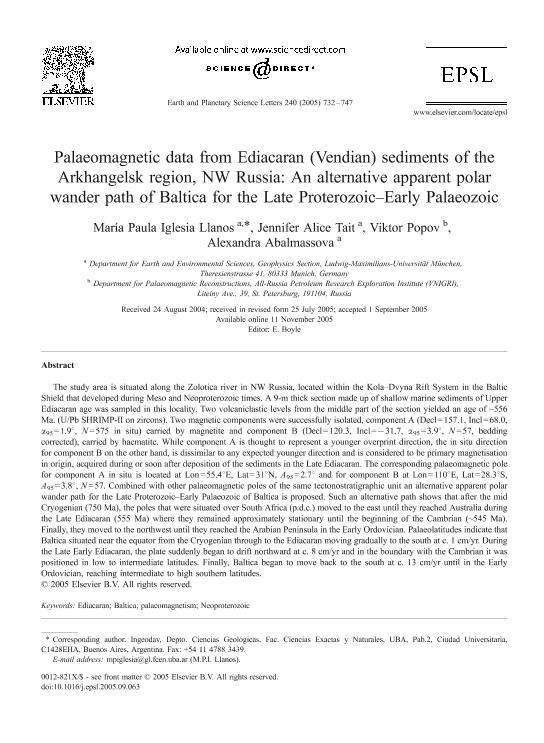Mostrar el registro sencillo del ítem
dc.contributor.author
Iglesia Llanos, Maria Paula

dc.contributor.author
Tait, J. A.
dc.contributor.author
Popov, V.
dc.contributor.author
Abalmassova, A.
dc.date.available
2019-12-23T17:17:43Z
dc.date.issued
2005-12
dc.identifier.citation
Iglesia Llanos, Maria Paula; Tait, J. A.; Popov, V.; Abalmassova, A.; Palaeomagnetic data from Ediacaran (Vendian) sediments of the Arkhangelsk region, NW Russia: An alternative apparent polar wander path of Baltica for the Late Proterozoic-Early Palaeozoic; Elsevier Science; Earth and Planetary Science Letters; 240; 3-4; 12-2005; 732-747
dc.identifier.issn
0012-821X
dc.identifier.uri
http://hdl.handle.net/11336/92776
dc.description.abstract
The study area is situated along the Zolotica river in NW Russia, located within the Kola-Dvyna Rift System in the Baltic Shield that developed during Meso and Neoproterozoic times. A 9-m thick section made up of shallow marine sediments of Upper Ediacaran age was sampled in this locality. Two volcaniclastic levels from the middle part of the section yielded an age of ∼556 Ma. (U/Pb SHRIMP-II on zircons). Two magnetic components were successfully isolated, component A (Decl = 157.1, Incl = 68.0, α95 = 1.9°, N = 575 in situ) carried by magnetite and component B (Decl = 120.3, Incl = - 31.7, α95 = 3.9°, N = 57, bedding corrected), carried by haematite. While component A is thought to represent a younger overprint direction, the in situ direction for component B on the other hand, is dissimilar to any expected younger direction and is considered to be primary magnetisation in origin, acquired during or soon after deposition of the sediments in the Late Ediacaran. The corresponding palaeomagnetic pole for component A in situ is located at Lon = 55.4°E, Lat = 31°N, A95 = 2.7° and for component B at Lon = 110°E, Lat = 28.3°S, A95 = 3.8°, N = 57. Combined with other palaeomagnetic poles of the same tectonostratigraphic unit an alternative apparent polar wander path for the Late Proterozoic-Early Palaeozoic of Baltica is proposed. Such an alternative path shows that after the mid Cryogenian (750 Ma), the poles that were situated over South Africa (p.d.c.) moved to the east until they reached Australia during the Late Ediacaran (555 Ma) where they remained approximately stationary until the beginning of the Cambrian (∼545 Ma). Finally, they moved to the northwest until they reached the Arabian Peninsula in the Early Ordovician. Palaeolatitudes indicate that Baltica situated near the equator from the Cryogenian through to the Ediacaran moving gradually to the south at c. 1 cm/yr. During the Late Early Ediacaran, the plate suddenly began to drift northward at c. 8 cm/yr and in the boundary with the Cambrian it was positioned in low to intermediate latitudes. Finally, Baltica began to move back to the south at c. 13 cm/yr until in the Early Ordovician, reaching intermediate to high southern latitudes.
dc.format
application/pdf
dc.language.iso
eng
dc.publisher
Elsevier Science

dc.rights
info:eu-repo/semantics/openAccess
dc.rights.uri
https://creativecommons.org/licenses/by-nc-sa/2.5/ar/
dc.subject
Ediacaran
dc.subject
Baltica
dc.subject
Palaeomagnetism
dc.subject
Neoproterozoic
dc.title
Palaeomagnetic data from Ediacaran (Vendian) sediments of the Arkhangelsk region, NW Russia: An alternative apparent polar wander path of Baltica for the Late Proterozoic-Early Palaeozoic
dc.type
info:eu-repo/semantics/article
dc.type
info:ar-repo/semantics/artículo
dc.type
info:eu-repo/semantics/publishedVersion
dc.date.updated
2019-07-15T14:19:44Z
dc.journal.volume
240
dc.journal.number
3-4
dc.journal.pagination
732-747
dc.journal.pais
Países Bajos

dc.journal.ciudad
Amsterdam
dc.description.fil
Fil: Iglesia Llanos, Maria Paula. Consejo Nacional de Investigaciones Científicas y Técnicas. Oficina de Coordinación Administrativa Ciudad Universitaria. Instituto de Geociencias Básicas, Aplicadas y Ambientales de Buenos Aires. Universidad de Buenos Aires. Facultad de Ciencias Exactas y Naturales. Instituto de Geociencias Básicas, Aplicadas y Ambientales de Buenos Aires; Argentina. Universität München; Alemania
dc.description.fil
Fil: Tait, J. A.. Universität München; Alemania
dc.description.fil
Fil: Popov, V.. All-Russia Petroleum Research Exploration Institute; Rusia
dc.description.fil
Fil: Abalmassova, A.. Universität München; Alemania
dc.journal.title
Earth and Planetary Science Letters

dc.relation.alternativeid
info:eu-repo/semantics/altIdentifier/doi/http://dx.doi.org/10.1016/j.epsl.2005.09.063
dc.relation.alternativeid
info:eu-repo/semantics/altIdentifier/url/https://www.sciencedirect.com/science/article/pii/S0012821X0500573X
Archivos asociados
